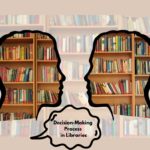Reference Interview: When the user needs information, he applies for information at the reference desk. That is, he requests information. The reference librarian or staff may not understand all types of applications or questions. In such cases, the reference staff asks the questioner questions to find out what information the user actually needs. He learns about the user’s research. This makes his search process easier and can provide information quickly. In such cases, an interview is conducted. A reference interview refers to a dialogue and conversation between a reference librarian and the user. If the reference question is asked by telex, fax, e-mail, or post, then the scope of a reference interview is less. If the question comes by telephone, then a short interview can be conducted. It is better if the questioner is physically present and requests information.
The main purpose of the reference interview is to provide information quickly by understanding the reference question well. The reference librarian knows what the user wants. Many readers do not know how to ask questions or understand what they need. Many do not know how to use reference materials. In such cases, the reference librarian goes further and extends a helping hand to the users. He helps them in various ways. In this case, the reference interview plays an effective role. Therefore, the role of reference interviews in providing good reference services is immense.

A reference interview is a structured conversation between a librarian or information professional and a patron that aims to clarify the patron’s information needs. The goal is to identify what the patron is truly looking for and to provide the most relevant resources.
There are several types of reference interviews based on their approach and context:
- Open Reference Interview: This type involves broad, exploratory questions that encourage patrons to express their needs freely. It is useful when patrons are unsure of what they need or when the inquiry is complex. For example, the librarian may ask, “Can you tell me more about the topic you’re interested in?”
- Closed Reference Interview: This approach involves specific, direct questions to quickly identify the patron’s exact need. It is suitable for those who have a clear idea of their requirements. For instance, the librarian might ask, “Do you need books or journal articles on this subject?”
- Directional Reference Interview: This type focuses on guiding the patron to a specific resource, location, or service without delving deeply into the content. An example would be saying, “The medical textbooks are in the 610 section on the second floor.”
- Ready Reference Interview: This interview deals with quick, factual questions that require immediate answers, often involving statistics, addresses, or definitions. For instance, the librarian might ask, “What is the capital of France?”
- Research Reference Interview: This involves in-depth, complex inquiries that require extensive investigation and is often used by researchers or students working on detailed projects.
- Negotiated Reference Interview: This type involves back-and-forth communication to refine and clarify the patron’s request, with the librarian collaborating to narrow down their needs. An example question could be, “Are you looking for recent studies or historical perspectives?”
- Virtual Reference Interview: Conducted via online chat, email, or video conferencing, this interview requires adapting questioning techniques to a digital medium. For instance, a librarian might assist a remote user through live chat.
- Telephone Reference Interview: This interview is conducted over the phone and often requires concise questioning to clarify user needs. Challenges include the absence of visual cues; for example, the librarian might ask, “Are you looking for peer-reviewed journals or general information?”
Each type of reference interview plays a critical role in ensuring effective information retrieval and enhancing user satisfaction.
Steps to answer reference questions:
The user applies to the reference desk for information. In this case, the reference staff takes various steps to answer the questions received. The steps are taken sequentially, that is, one step after another. These steps are shown in the flow chart below.
| The user feels the need for information |
↓
| The information requirement is presented in the form of a question |
↓
| The reference staff receives the questions directly, by telephone, telex, e-mail, postal mail, or other means. |
↓
| The reference librarian decides on the process of answering the questions. |
↓
| The question is answered by search strategy |
↓
| The search process is conducted (the search is done manually or mechanically) |
↓
| Relevant and relevant information is collected. |
↓
| The collected information is provided to the inquirer. |
↓
| The user expresses satisfaction with the information and carries out his/her activities. |
↓
| If the user needs more information, he/she informs his/her country. The reference library staff provides further research to collect more relevant information. |
Service Demand Slip
When a user comes to the reference desk, he is asked to fill out a service request form. The user may not actually need to fill out such a request form to get general information. The user can express his real needs through the service request form. He feels free in this. Many readers may be annoyed. Although some readers feel annoyed, it still has a positive role. Especially in the statistical aspect of reference services, its need is very high. The demand letter also has a role in evaluating reference services. The information included in the service demand letter may be different in each library. However, some things can be found in common. Its main purpose is to determine the real needs of the user. Therefore, it would not be wrong to say that there is a need for any library service demand letter.
| Sample of Service Request Letter |
| Name of library |
| Service Request Letter |
| Reader’s name : | |
| Position : | |
| Full address : | |
| Email, Telephone Number (if any): | |
| Educational Qualification: | |
| Library membership number (if any): | |
| Subject of information sought: | |
| In which language do you want to get information? | |
| Do you want to get photocopy?: | |
| Do you want to get computer search service?: | |
| Signature: | |
| Date: |
| For library use |
| Date of service provided: | |
| Name of the source of information: | |
| Reason for non-service: | |
| Amount received for photocopy/computer search | |
| Reference Employee Name | |
| Rank | |
| Signature | |
| Date |
In conclusion, reference interviews, through their various types and structured steps, are essential for effectively understanding and addressing a patron’s information needs, ensuring that users receive accurate and relevant resources tailored to their inquiries.



